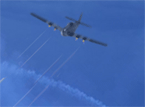As your lordship knows, the Swedish Army of 65,000 men which I have the honour of commanding has spent the last several months beseiging the city of Gronginen, the capital of Friedland, while hearing rumours of the French Grand Armee being in such unlikely places as Styria and even Moscva. Regardless of where the Grande Armees were, I can inform your lordship that most recently they were definitely in Friedland!
Grand Armees I and II, the Batavian Army, and the Bavarian Army, numbering over 190,000 men made a lightning move into the region and attacked our army! Although some dozen generals accompanied the armies, Napolean was not present - Lannes commanded the French.
To the north of the city I identified some defensible terrain, and decided to fight the battle there. While our infantry and artillery units deployed into that zone, General Buxhoven led our 2 cavalry divisions in a a charge to permit our supply caisson to make the defensive line before the enemy could capture it. Unfortunately, both cavalry divisions were surrounded by the advancing French forces and driven from the field of battle - but they accomplished their objective. General Buxhoven switched from the cavalry to harry the caissons into our defensive perimeter just as a wave of French cavalry divisions reached us. We were able to put our backs to the ocean, and brace each flank on difficult terrain. The illustration below shows our position.
In our frontline, the 5th Jager Infantry adopted a square and put out skirmishers - they stood dozens of attacks from the French cavalry and then infantry without flinching. They conserved their energy for defending their positions, and did not indulge in charges or fire attacks. Similiarly, on their flank the 1st Infantry adopted a square and withstood repeated enemy assaults. Meanwhile, the other three infantry divisions and the artillery adopted a line formation and fired over the broken ground into the flanks and rear of French units. The supply caisson made an enormous contribution to the battle and fully justified the sacrifice of our cavalry to bring them safely into the defensive position - they were able to continually resupply the infantry and artillery divisions, which kept their morale high.
There was a difficult moment when enemy cavalry crossed the broken terrain into our rear, but fortunately only one of the 4 divisions was in order: and it was soon broken by point blank artillery fire. Our forces stood firm, and were the rock upon which the French armies broke themselves. I have the honour to report a victory!
We captured the French 19th and 21st Artillery during the French retreat, and their guns will henceforth fire for Sweden. We also accepted the surrender of 8 other divisions - the 15th and 17th Cavalry, 1st, 2nd and 26th Infantry, the 21st Light Infantry, and the 22nd and 28th Artillery.
Although we inflicted over 20,000 casulties and took only 10,000 - and captured a further 24,000 men, that still leaves the French forces in this area at 150,000 men - almost 3:1 against us. I will retreat the army through Denmark, endeavouring to keep the prisoners from the French. If forced to battle, we will do our duty once again! Given the superior mobility of the French Armies (how do they move so quickly?), I recommend you muster the new divisions into a corps in Malmo - just in case they get there before us.
I have the honour, sir, to be your obedient servant,
Klingspor








